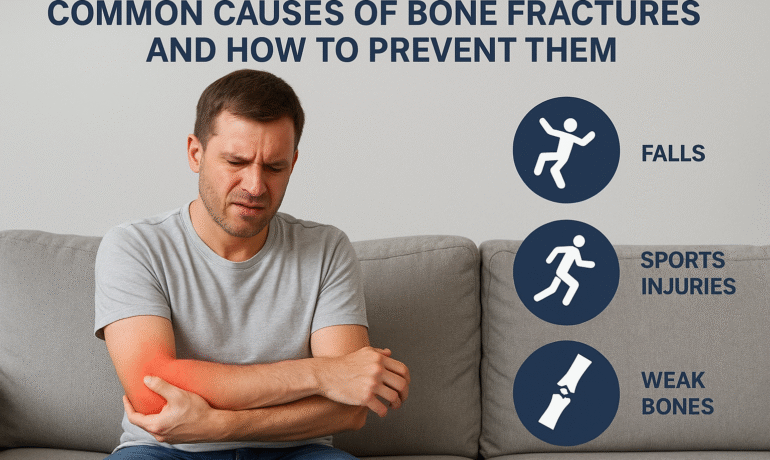Bone fractures are among the most frequent orthopedic injuries, affecting people of all ages. They occur when a bone is subjected to more force than it can withstand, leading to cracks or complete breaks. Understanding the common causes of bone fractures and adopting preventive strategies can protect bone health and overall mobility.
1. Understanding Bone Fractures
A bone fracture refers to any break in the bone structure, ranging from minor cracks to complete separations. These injuries can result from trauma, medical conditions, or repetitive stress. Depending on severity, fractures are classified as simple, compound, hairline, or comminuted fractures.
2. Major Causes of Bone Fractures
a. Accidents and Trauma
High-impact injuries from road accidents, sports, or falls are leading causes of bone fractures. The sudden pressure or force can exceed the bone’s natural strength, resulting in a break.
b. Osteoporosis
Osteoporosis weakens bone density, making them more prone to fractures even from minor impacts or slips. This condition commonly affects older adults, especially post-menopausal women.
c. Repetitive Stress or Overuse
Athletes and laborers often experience stress fractures caused by repetitive motion or overtraining. Continuous strain weakens the bone over time, leading to small cracks.
d. Nutritional Deficiencies
Lack of calcium, vitamin D, and essential minerals can compromise bone strength. Poor diet and limited sunlight exposure contribute to fragile bones.
e. Medical Conditions
Certain diseases like osteogenesis imperfecta, cancer, or infections can weaken the bone structure, making it more susceptible to breaks.
3. Symptoms of a Bone Fracture
Common signs include:
Sudden pain and swelling
Deformity at the injury site
Difficulty in movement or bearing weight
Bruising or tenderness around the bone
Immediate medical attention is necessary to confirm the type and severity of the fracture.
4. How to Prevent Bone Fractures
a. Maintain Strong Bone Health
Incorporate calcium-rich foods, such as milk, leafy greens, and fortified cereals. Regularly take vitamin D through sunlight or supplements to support bone strength.
b. Engage in Weight-Bearing Exercises
Activities like walking, jogging, and resistance training strengthen bones and improve balance, reducing fall risks.
c. Prevent Falls
Ensure home safety by using anti-slip mats, adequate lighting, and supportive footwear. Elderly individuals should consider balance training and fall-prevention programs.
d. Avoid Overtraining
Allow the body proper rest and recovery. Gradual progression in physical activity prevents stress fractures and injuries.
e. Regular Check-Ups
Periodic bone density tests help identify early signs of weakness or osteoporosis, enabling timely medical intervention.
5. Treatment and Recovery
Fracture treatment depends on the type and severity of the injury. Options include casting, splinting, or orthopedic surgery for complex cases. Physiotherapy is crucial for restoring movement and strength post-recovery. Consult our Best Orthopedic Surgeon in Hyderabad Dr. Vinaykumar H for accurate diagnosis and advanced treatment.
Conclusion
Bone fractures can impact quality of life, but preventive measures like balanced nutrition, exercise, and regular check-ups can reduce risks.
Protect your bones today—prioritize bone health and safety every day.
If you experience any fracture or bone pain, seek immediate care from our Best Orthopedic Surgeon in Hyderabad Dr. Vinaykumar H.



